A Multi-Criteria Reference Point Based Approach for Assessing Regional Innovation Performance in Spain
Abstract
1. Introduction
- The first question examines the issue of how the decision makers could provide preferential information making use of reference levels to define performance intervals from the beginning, depending upon the scope and aim of the composite innovation index. The point of establishing the reference levels is that the resulting composite innovation index is an easy-to-interpret measure in terms of a comparability analysis of regions at national or European level.
- The second question is: how does the compensability of individual indicators affect the overall ranking of regions when evaluating their innovation performance? The level of compensability defined when the individual indicators are aggregated has strong policy-making implications. From full compensation(weak) to no-compensation aggregation (strong) rules, we can obtain different composite innovation indices that aid the users to identify weak and strong points of each region and design policies accordingly.
2. Composite Innovation Indices: A Literature Review
3. Research Design and Methodology for Reference Point Based Regional Innovation Composite Indicator
3.1. Parameters: Weights and Reference Levels
- On the one hand, we will adapt the benchmarks used by the RIS (Modest, Moderate, Strong, Leader) at an European level, as described in Section 4.1. This way, we establish the behaviour of the Spanish regions with respect to all the European ones, following these benchmarks.
- On the other hand, we will use percentiles 25, 50 and 75 across all the Spanish regions. This way, we can see the relative position of each region also with respect to the Spanish regions only. This will let us illustrate the effect of using different reference levels in the MRP-WSCI approach.
3.2. Normalization: The Achievement Scalarizing Function
3.3. Full Compensation: The Weak Composite Indicator
3.4. No Compensation: The Strong Composite Indicator
3.5. Successive Aggregations
- First Aggregation. We obtain for each region the and of each innovation dimension. If the region is understood from the context, they will be simply denoted as W and S and they measure:
- -
- W: the average (compensatory) measure of the dimension;
- -
- S: the worst indicator of the dimension.
- Second Aggregation. Given the way W and S have been constructed, these composite indicators take values in the same scale, 0-1-2-3-4, as the original achievement scalarizing functions, and therefore, they can be used as achievement function in the following aggregations. Thus, in the second aggregation, one of these composite indicators is used as achievement functions to build the composite indicators of each type.If the weak composite indicators are used as achievement functions, we get two composite indicators for each type:
- -
- W-W, the weak-weak composite indicator, measures the average (compensatory) performance of the type;
- -
- S-W, the strong-weak composite indicator, points out the worst dimension of the type.
Alternatively, the strong composite indicators of each innovation dimension can be used as achievement functions in the second stage. In this case, it is interesting to consider:- -
- S-S, the strong-strong indicator, which points out the worst single indicator of each type.
- Third Aggregation. Finally, the same considerations can be made for the last aggregation stage, where we obtain global composite indicators for each region. In this case, we will consider:
- -
- W-W-W, which gives an overall compensatory measure of each region;
- -
- S-W-W, which points out the worst type of each region;
- -
- S-S-S, which indicates the worst single indicator of each region.
3.6. A New Visualization Tool: The Light-Diagram
4. Benchmarking Spanish Regional Innovation Performance According to European Reference Levels
4.1. Defining EU Relative Reference Levels
- Regions performing between the minimum value of the indicator, , and 50% of the EU average, , are regarded as Modest Innovators ().
- Regions performing between and 90% of the EU average, , are regarded as Moderate Innovators ().
- Regions performing between and 120% of the EU average, , are regarded as Strong Innovators (S).
- Regions performing between and the maximum value of the indicator, , are regarded as Leaders (L).
4.2. Profiling Regional Innovation Performances: Results and Visualization Tools
5. Setting National Reference Levels: A Country-Level Analysis
6. Conclusions
- How can decision makers provide preferential information making use of reference levels, depending upon the scope and aim of the composite innovation index?
- How does the compensability of single indicators affect the overall ranking of regions when evaluating their innovation performance?
Author Contributions
Funding
Acknowledgments
Conflicts of Interest
Appendix A
| Framework Conditions () | Indicator | Definition Numerator | Definition Denominator |
|---|---|---|---|
| Human Resources () | Population with tertiary education () | Number of persons in age class with some form of post secondary education | Total population between 30 and 34 years |
| Lifelong Learning () | Number of persons in private households aged between 25 and 64 years who have participated in the four weeks preceding the interview, in any education or training... | Total population aged between 25 and 64 years | |
| Attractive research systems () | Scientific Co-Publications () | Number of scientific publications with at least one co author based abroad | Total population |
| Most-cited publications () | Number of scientific publications among the top 10% most cited publications worldwide | Total number of scientific publications | |
| Investments () | Indicator | Definition Numerator | Definition Denominator |
| Finance and support () | R&D expenditures in the public sector as percentage of GDP (R&D expenditure public sector) () | All R&D expenditures in the government sector (GOVERD) and the higher education sector (HERD) | Regional Gross Domestic Product |
| Firm investments () | R& D expenditure business sector () | All R&D expenditures in the business sector (BERD) | Regional Gross Domestic Product |
| Non-R& D innovation expenditures () | Sum of total innovation expenditure for SMEs | Total turnover for SMEs | |
| Innovation Activities () | Indicator | Definition Numerator | Definition Denominator |
| Innovators () | Product or Process Innovators () | Number of SMEs that introduced a new product or a new process to one of their markets | Total number of SMEs |
| Marketing or organisational innovators () | Number of SMEs that introduced a new marketing innovation and/or organisational innovation to one of their markets | Total number of SMEs | |
| SMEs innovating in-house () | Number of SMEs with in house innovation activities. | Total number of SMEs | |
| Linkages () | Innovative SMEs collaborating () | Number of SMEs with innovation co operation activities. | Total number of SMEs |
| Public-private co-publications () | Number of public private co authored research publications. | Total population | |
| Intellectual Assets () | EPO patent applications per billion regional GDP (EPO patent applications) () | Number of patents applied for at the European Patent Office (EPO), by year of filing | Gross Domestic Product in Purchasing Power Standard |
| Trademark applications per billion regional GDP (Trademark Applications) () | Number of trademarks applied for at EUIPO | Gross Domestic Product in Purchasing Power Standard | |
| Design applications per billion regional GDP (Design applications) () | Number of designs applied for at EUIPO | Gross Domestic Product in Purchasing Power Standard | |
| Impacts () | Indicator | Definition Numerator | Definition Denominator |
| Employment () | Employment in medium high/high tech manufacturing and knowledge intensive services as percentage of total workforce () | Number of employed persons in the medium high and high tech manufacturing sectors. | Total workforce including all manufacturing and service sectors |
| Sales Impact () | Sales of new to market and new to firm innovations in SMEs as percentage of turnover () | Sum of total turnover of new or significantly improved products for SMEs | Total turnover for SMEs |
References
- Hauser, C.; Siller, M.; Schatzer, T.; Walde, J.; Tappeiner, G. Measuring regional innovation: A critical inspection of the ability of single indicators to shape technological change. Technol. Forecast. Soc. Chang. 2018, 129, 43–55. [Google Scholar] [CrossRef]
- Makkonen, T.; van der Have, R.P. Benchmarking regional innovative performance: Composite measures and direct innovation counts. Scientometrics 2013, 94, 247–262. [Google Scholar] [CrossRef]
- Asheim, B.T.; Smith, H.L.; Oughton, C. Regional innovation systems: Theory, empirics and policy. Reg. Stud. 2011, 45, 875–891. [Google Scholar] [CrossRef]
- Buesa, M.; Heijs, J.; Baumert, T. The determinants of regional innovation in Europe: A combined factorial and regression knowledge production function approach. Res. Policy 2010, 39, 722–735. [Google Scholar] [CrossRef]
- Schmookler, J. The interpretation of patent statistics. J. Pat. Off. Soc. 1950, 32, 123–146. [Google Scholar]
- Di Cagno, D.; Fabrizi, A.; Meliciani, V.; Wanzenböck, I. The impact of relational spillovers from joint research projects on knowledge creation across European regions. Technol. Forecast. Soc. Chang. 2016, 108, 83–94. [Google Scholar] [CrossRef]
- Griliches, Z. R& D, Patents and Productivity; University of Chicago Press: Chicago, IL, USA, 1984. [Google Scholar]
- Capello, R.; Lenzi, C. Territorial patterns of innovation: A taxonomy of innovative regions in Europe. Ann. Reg. Sci. 2013, 51, 119–154. [Google Scholar] [CrossRef]
- Navarro, M.; Gibaja, J.J.; Bilbao-Osorio, B.; Aguado, R. Patterns of innovation in EU-25 regions: A typology and policy recommendations. Environ. Plan. C Gov. Policy 2009, 27, 815–840. [Google Scholar] [CrossRef]
- Pinto, H. The diversity of innovation in the European Union: Mapping latent dimensions and regional profiles. Eur. Plan. Stud. 2009, 17, 303–326. [Google Scholar] [CrossRef]
- Nardo, M.; Saisana, M.; Saltelli, A.; Tarantola, S.; Hoffman, A.; Giovannini, E. Handbook on Constructing Composite Indicators; OECD Publishing: Paris, France, 2008. [Google Scholar]
- Ruiz, F.; El Gibari, S.; Cabello, J.M.; Gómez, T. MRP-WSCI: Multiple reference point based weak and strong composite indicators. Omega 2019. [Google Scholar] [CrossRef]
- Hollenstein, H. A composite indicator of a firm’s innovativeness: An empirical analysis based on survey data for Swiss manufacturing. Res. Policy 1996, 25, 633–645. [Google Scholar] [CrossRef]
- Feeny, S.; Rogers, M. Innovation and performance: Benchmarking Australian firms. Aust. Econ. Rev. 2003, 36, 253–264. [Google Scholar] [CrossRef]
- Gu, W.; Tang, J. Link between innovation and productivity in Canadian manufacturing industries. Econ. Innov. New Technol. 2004, 13, 671–686. [Google Scholar] [CrossRef]
- Tang, J.; Le, C.D. Multidimensional innovation and productivity. Econ. Innov. New Technol. 2007, 16, 501–516. [Google Scholar] [CrossRef]
- Cobo, A.; Rocha, E.R.; Villamizar, M.A. Innovative propensity with a fuzzy multicriteria approach: Analysis of the Spanish industrial sector with data mining techniques. Manag. Decis. 2019, 57, 2940–2957. [Google Scholar] [CrossRef]
- Kumar, S.; Haleem, A.; Sushil. Assessing innovativeness of manufacturing firms using an intuitionistic fuzzy based MCDM framework. Benchmarking 2019, 26, 1823–1844. [Google Scholar] [CrossRef]
- Zemlickienė, V.; Turskis, Z. Evaluation of the expediency of technology commercialization: A case of information technology and biotechnology. TEchnological Econ. Dev. Econ. 2020, 26, 271–289. [Google Scholar] [CrossRef]
- OECD. Handbook on Constructing Composite Indicators: Methodology and User Guide; OECD Publishing: Paris, France, 2008. [Google Scholar]
- Dutta, S.; Lanvin, B.; Wunsch-Vincent, S. The Global Innovation Index 2018: Energizing the World with Innovation; Ithaca: Fontainebleau, France, 2019. [Google Scholar]
- European Commission (Ed.) Third European Report on Science & Technology Indicators 2003; EUR 20025 EN; European Commission: Brussels, Belgium, 2003. [Google Scholar]
- Grupp, H.; Mogee, M.E. Indicators for national science and technology policy: How robust are composite indicators? Res. Policy 2004, 33, 1373–1384. [Google Scholar] [CrossRef]
- Schibany, A.; Streicher, G. The European innovation scoreboard: Drowning by numbers? Sci. Public Policy 2008, 35, 717–732. [Google Scholar] [CrossRef]
- Grupp, H.; Schubert, T. Review and new evidence on composite innovation indicators for evaluating national performance. Res. Policy 2010, 39, 67–78. [Google Scholar] [CrossRef]
- Adam, F. Measuring National Innovation Performance: The Innovation Union Scoreboard Revisited; Springer: Berlin, Germany, 2014. [Google Scholar]
- Edquist, C.; Zabala, J.M. The Innovation Union Scoreboard Is Flawed: The Case of Sweden—Not Being the Innovation Leader of the EU; CIRCLE: Lund, Sweden, 2015. [Google Scholar]
- Kozłowski, J. Innovation indices: The need for positioning them where they properly belong. Scientometrics 2015, 104, 609–628. [Google Scholar] [CrossRef] [PubMed]
- Carayannis, E.G.; Goletsis, Y.; Grigoroudis, E. Composite innovation metrics: MCDA and the Quadruple Innovation Helix framework. Technol. Forecast. Soc. Chang. 2018, 131, 4–17. [Google Scholar] [CrossRef]
- Saisana, M.; Tarantola, S. State-of-The-Art Report on Current Methodologies and Practices for Composite Indicator Development; Technological and Economic Risk Management Unit, Institute for the Protection and the Security of the Citizen, Joint Research Centre, European Commission: Ispra, Italy, 2002; Volume 2014. [Google Scholar]
- Greco, S.; Ishizaka, A.; Tasiou, M.; Torrisi, G. On the methodological framework of composite indices: A review of the issues of weighting, aggregation, and robustness. Soc. Indic. Res. 2019, 141, 61–94. [Google Scholar] [CrossRef]
- Nardo, M.; Saisana, M.; Saltelli, A.; Tarantola, S. Tools for Composite Indicators Building; European Commission, Joint Research Centre, Institute for the Protection and the Security of the Citizen, Technological and Economic Risk Management Unit: Ispra, Italy, 2005. [Google Scholar]
- Jacobs, R.; Smith, P.C.; Goddard, M.K. Measuring Performance: An Examination of Composite Performance Indicators; Centre of Health Economics, University of York: York, UK, 2004. [Google Scholar]
- Freudenberg, M. Composite Indicators of Country Performance: A Critical Assessment; OECD Science, Technology and Industry Working Papers, 2003/16; OECD Publishing: Paris, France, 2003. [Google Scholar]
- Saisana, M.; Domínguez-Torreiro, M.; Vértesy, D.; Alvarez, M. Joint Research Centre Statistical Audit of the 2018 Global Innovation Index; Cornell University, INSEAD, WIPO, The Global innovation Index 2018; Energizing the World with Innovation: Fontainebleau, France, 2018; pp. 71–88. [Google Scholar]
- El Gibari, S.; Gómez, T.; Ruiz, F. Building composite indicators using multicriteria methods: A review. J. Bus. Econ. 2019, 89, 1–24. [Google Scholar] [CrossRef]
- Diaz-Balteiro, L.; González-Pachón, J.; Romero, C. Measuring systems sustainability with multi-criteria methods: A critical review. Eur. J. Oper. Res. 2017, 258, 607–616. [Google Scholar] [CrossRef]
- Wierzbicki, A.P. The Use of Reference Objectives in Multiobjective Optimization. In Multiple Criteria Decision Making Theory and Application; Fandel, G., Gal, T., Eds.; Springer: Berlin/Heidelberg, Germany, 1980; pp. 468–486. [Google Scholar]
- Ruiz, F.; Cabello, J.M.; Luque, M. An application of reference point techniques to the calculation of synthetic sustainability indicators. J. Oper. Res. Soc. 2011, 62, 189–197. [Google Scholar] [CrossRef]
- Cabello, J.M.; Ruiz, F.; Pérez-Gladish, B.; Méndez-Rodríguez, P. Synthetic indicators of mutual funds’ environmental responsibility:An application of the Reference Point Method. Eur. J. Oper. Res. 2014, 236, 313–325. [Google Scholar] [CrossRef]
- Ruiz, F.; Cabello, J.M.; Pérez-Gladish, B. Building Ease-of-Doing-Business synthetic indicators using a double reference point approach. Technol. Forecast. Soc. Chang. 2018, 131, 130–140. [Google Scholar] [CrossRef]
- El Gibari, S.; Gómez, T.; Ruiz, F. Evaluating university performance using reference point based composite indicators. J. Inf. 2018, 12, 1235–1250. [Google Scholar] [CrossRef]
- Giarlotta, A. Multicriteria compensability analysis. Eur. J. Oper. Res. 2001, 133, 190–209. [Google Scholar] [CrossRef]
- Mazziotta, M.; Pareto, A. Measuring well-being over time: The adjusted Mazziotta–Pareto index versus other non-compensatory indices. Soc. Indic. Res. 2018, 136, 967–976. [Google Scholar] [CrossRef]
- Munda, G.; Nardo, M. On the Methodological Foundations of Composite Indicators Used for Ranking Countries; Joint Research Centre of the European Communities: Ispra, Italy, 2003; pp. 1–19. [Google Scholar]
- Munda, G.; Nardo, M. Noncompensatory/nonlinear composite indicators for ranking countries: a defensible setting. Appl. Econ. 2009, 41, 1513–1523. [Google Scholar] [CrossRef]
- Wierzbicki, A.P.; Makowski, M.; Wessels, J. (Eds.) Model-Based Decision Support Methodology with Environmental Applications; Kluwer Academic Publishers: Dordrecht, The Netherlands, 2000. [Google Scholar]
- Cabello, J.M.; Navarro, E.; Prieto, F.; Rodríguez, B.; Ruiz, F. Multicriteria development of synthetic indicators of the environmental profile of the Spanish regions. Ecol. Indic. 2014, 39, 10–23. [Google Scholar] [CrossRef]
- Munda, G.; Nardo, M. Constructing Consistent Composite Indicators: The Issue of Weights; European Commission: Brussels, Belgium, 2005. [Google Scholar]
- Hollanders, H.; Es-Sadki, N.; Kanerva, M. European Innovation Scoreboard 2016; European Commission: Brussels, Belgium, 2016. [Google Scholar]

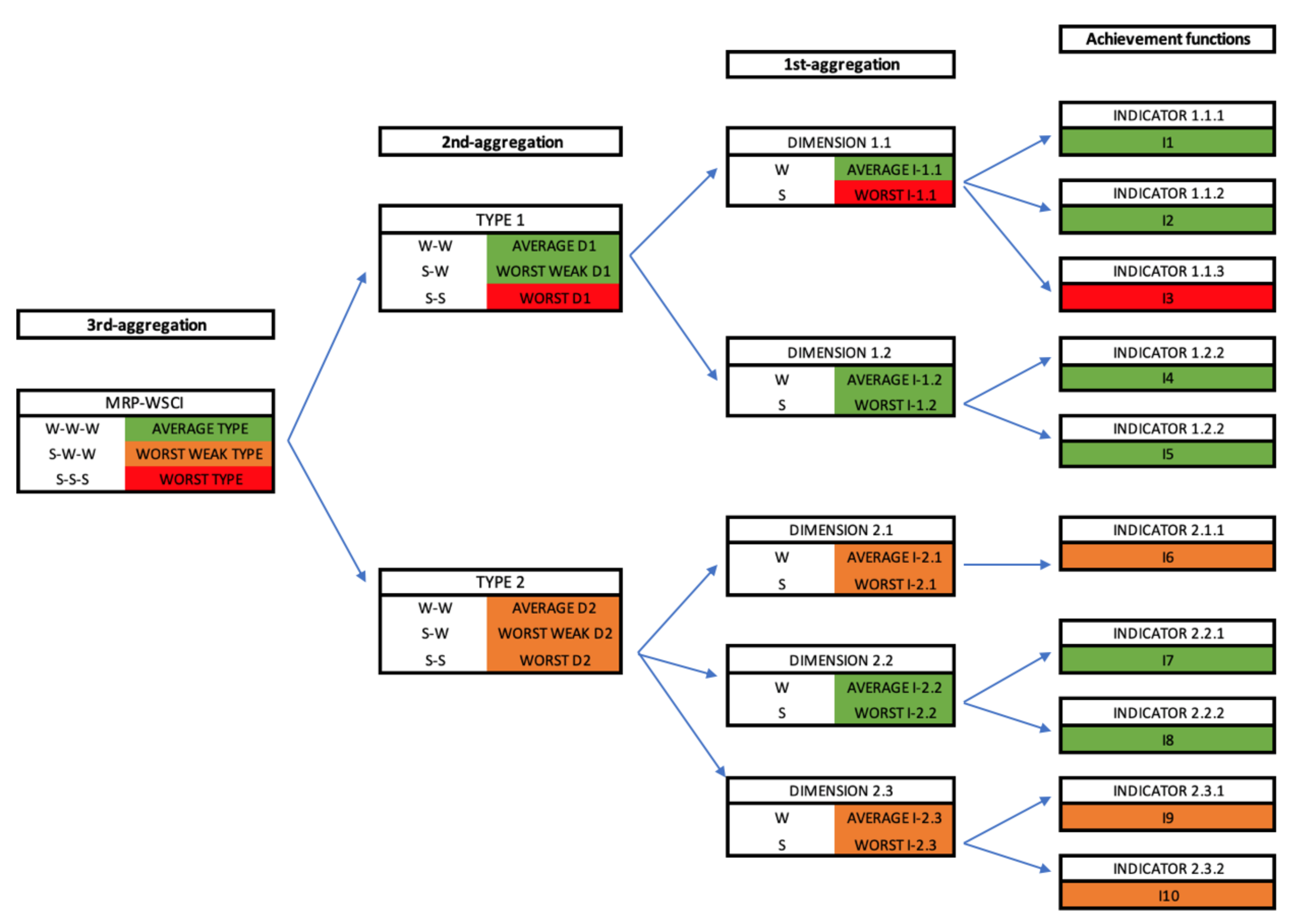
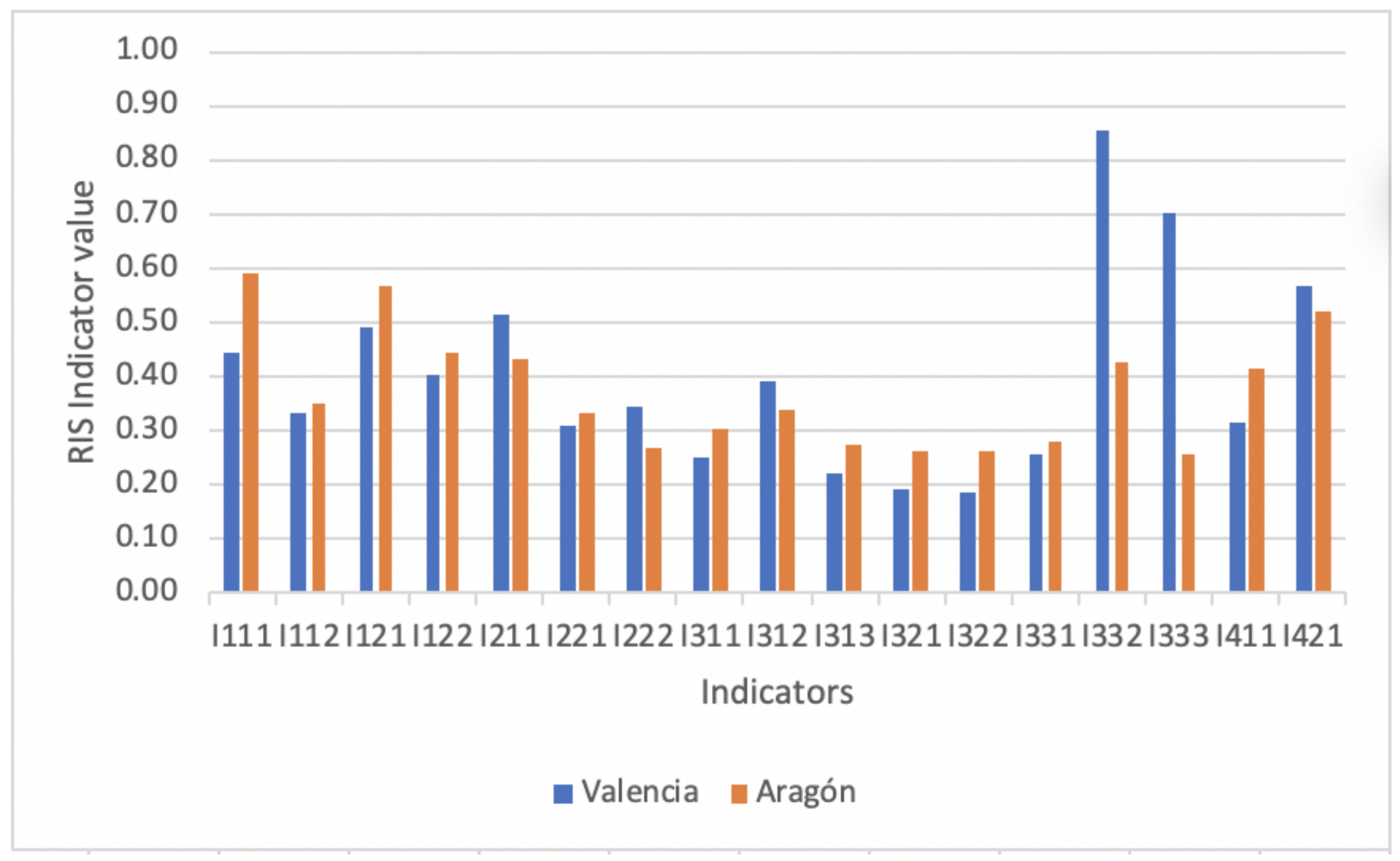

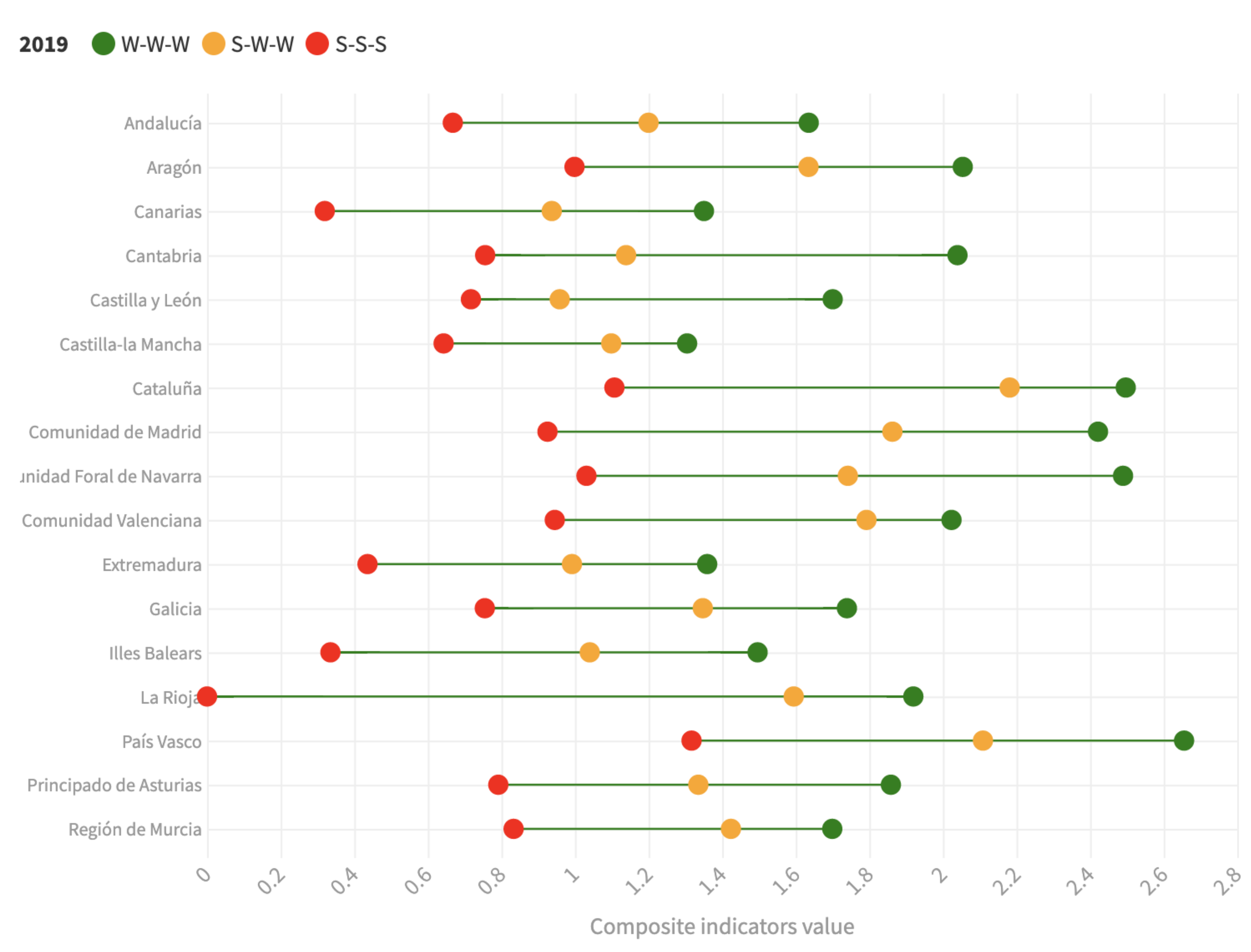
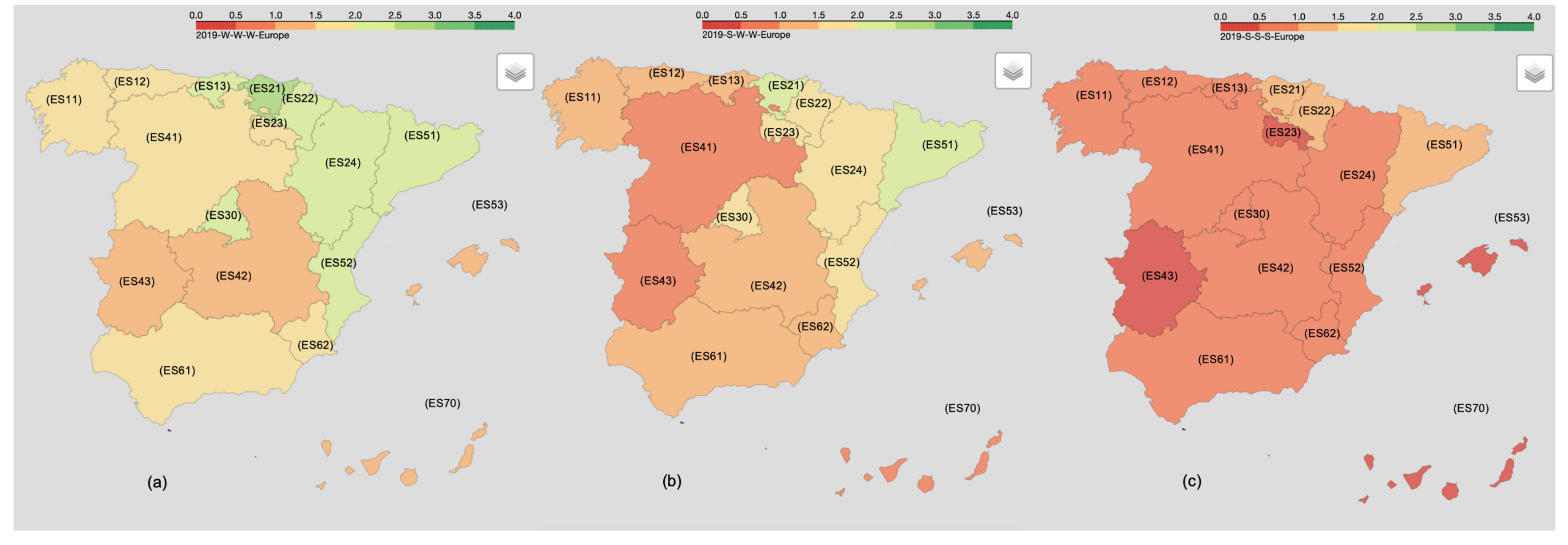
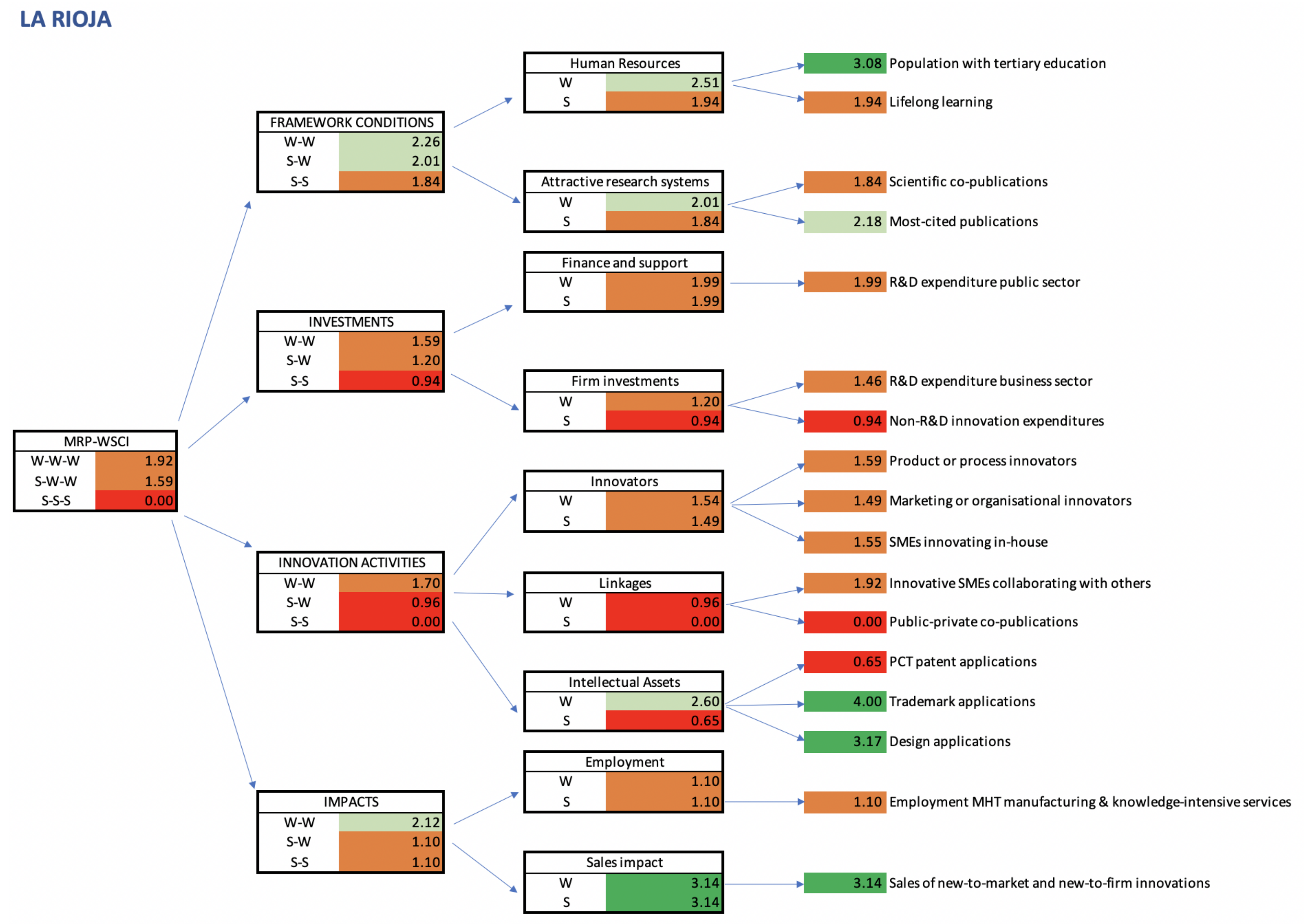


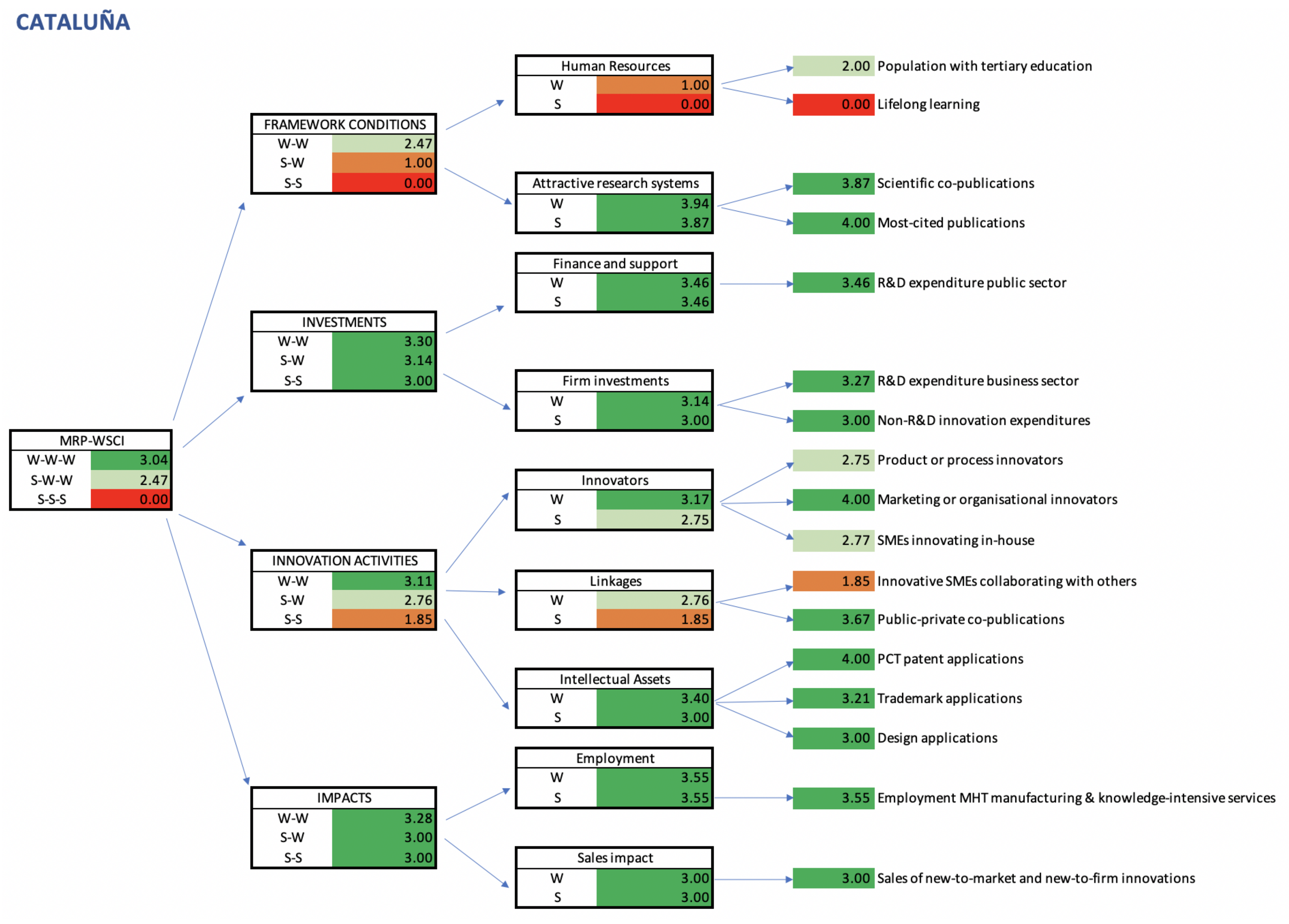

| Framework Conditions | S | L | |||||||
|---|---|---|---|---|---|---|---|---|---|
| Population with tertiary education | 0.00 | 0.21 | 0.38 | 0.51 | 1.00 | ||||
| Lifelong Learning | 0.00 | 0.16 | 0.29 | 0.38 | 1.00 | ||||
| Scientific Co-Publications | 0.00 | 0.25 | 0.45 | 0.60 | 1.00 | ||||
| Most-cited publications | 0.00 | 0.22 | 0.40 | 0.54 | 1.00 | ||||
| Framework Conditions | S | L | |||||||
| R&D expenditure public sector | 0.00 | 0.25 | 0.44 | 0.59 | 1.00 | ||||
| R&D expenditure business sector | 0.00 | 0.22 | 0.40 | 0.53 | 1.00 | ||||
| Non-R&D innovation expenditures | 0.00 | 0.27 | 0.48 | 0.64 | 1.00 | ||||
| Framework Conditions | S | ||||||||
| Product or Process Innovators | 0.00 | 0.24 | 0.43 | 0.58 | 1.00 | ||||
| Marketing-org innovators | 0.00 | 0.23 | 0.41 | 0.55 | 1.00 | ||||
| SMEs innovating in-house | 0.00 | 0.23 | 0.42 | 0.56 | 1.00 | ||||
| Innovative SMEs collaborating | 0.00 | 0.18 | 0.33 | 0.44 | 1.00 | ||||
| Public-private co-publications | 0.00 | 0.16 | 0.29 | 0.39 | 1.00 | ||||
| EPO patent applications | 0.00 | 0.16 | 0.29 | 0.39 | 1.00 | ||||
| Trademark Applications | 0.00 | 0.18 | 0.32 | 0.43 | 1.00 | ||||
| Design applications | 0.00 | 0.20 | 0.36 | 0.48 | 1.00 | ||||
| Framework Conditions | S | ||||||||
| Employment | 0.00 | 0.23 | 0.42 | 0.56 | 1.00 | ||||
| Sales of new to market | 0.00 | 0.26 | 0.47 | 0.62 | 1.00 |
| RII | W-W-W | S-W-W | S-S-S | ||||||
|---|---|---|---|---|---|---|---|---|---|
| Score | Rank | Score | Rank | Score | Rank | Score | Rank | ||
| ES21 | País Vasco | 79.84 | 1 | 2.66 | 1 | 2.11 | 2 | 1.32 | 1 |
| ES51 | Cataluña | 77.58 | 2 | 2.50 | 2 | 2.18 | 1 | 1.11 | 2 |
| ES22 | Comunidad Foral de Navarra | 75.45 | 3 | 2.49 | 3 | 1.74 | 5 | 1.03 | 3 |
| ES30 | Comunidad de Madrid | 74.02 | 4 | 2.42 | 4 | 1.86 | 3 | 0.93 | 6 |
| ES52 | Comunidad Valenciana | 69.28 | 5 | 2.02 | 7 | 1.79 | 4 | 0.95 | 5 |
| ES23 | La Rioja | 67.47 | 6 | 1.92 | 8 | 1.59 | 7 | 0.00 | 17 |
| ES24 | Aragón | 64.66 | 7 | 2.05 | 5 | 1.63 | 6 | 1.00 | 4 |
| ES13 | Cantabria | 60.23 | 8 | 2.04 | 6 | 1.14 | 12 | 0.76 | 9 |
| ES62 | Región de Murcia | 59.01 | 9 | 1.70 | 12 | 1.42 | 8 | 0.83 | 7 |
| ES12 | Principado de Asturias | 58.36 | 10 | 1.86 | 9 | 1.34 | 10 | 0.79 | 8 |
| ES11 | Galicia | 55.68 | 11 | 1.74 | 10 | 1.35 | 9 | 0.75 | 10 |
| ES53 | Illes Balears | 52.30 | 12 | 1.50 | 14 | 1.04 | 14 | 0.34 | 15 |
| ES41 | Castilla y León | 51.65 | 13 | 1.70 | 11 | 0.96 | 16 | 0.72 | 11 |
| ES61 | Andalucía | 51.03 | 14 | 1.64 | 13 | 1.20 | 11 | 0.67 | 12 |
| ES70 | Canarias | 46.06 | 15 | 1.35 | 16 | 0.94 | 17 | 0.32 | 16 |
| ES42 | Castilla-la Mancha | 44.68 | 16 | 1.30 | 17 | 1.10 | 13 | 0.64 | 13 |
| ES43 | Extremadura | 43.36 | 17 | 1.36 | 15 | 0.99 | 15 | 0.44 | 14 |
| Framework Conditions | (Min) | (P25) | (P50) | (P75) | (Max) |
|---|---|---|---|---|---|
| Population with tertiary education | 0.32 | 0.42 | 0.55 | 0.61 | 0.73 |
| Lifelong Learning | 0.21 | 0.26 | 0.28 | 0.33 | 0.38 |
| Scientific Co-Publications | 0.30 | 0.42 | 0.48 | 0.57 | 0.67 |
| Most-cited publications | 0.24 | 0.37 | 0.43 | 0.45 | 0.54 |
| Investments | (Min) | (P25) | (P50) | (P75) | (Max) |
| R&D expenditure public sector | 0.29 | 0.43 | 0.46 | 0.49 | 0.58 |
| R&D expenditure business sector | 0.10 | 0.28 | 0.31 | 0.40 | 0.61 |
| Non-R&D innovation expenditures | 0.22 | 0.25 | 0.27 | 0.29 | 0.36 |
| Innovation Activities | (Min) | (P25) | (P50) | (P75) | (Max) |
| Product or Process Innovators | 0.13 | 0.20 | 0.25 | 0.30 | 0.35 |
| Marketing or organisational innovators | 0.23 | 0.29 | 0.31 | 0.34 | 0.40 |
| SMEs innovating in-house | 0.09 | 0.18 | 0.22 | 0.28 | 0.35 |
| Innovative SMEs collaborating | 0.06 | 0.13 | 0.22 | 0.28 | 0.44 |
| Public-private co-publications | 0.00 | 0.14 | 0.17 | 0.23 | 0.48 |
| EPO patent applications | 0.08 | 0.12 | 0.21 | 0.25 | 0.35 |
| Trademark Applications | 0.19 | 0.31 | 0.42 | 0.74 | 1.00 |
| Design applications | 0.09 | 0.21 | 0.27 | 0.45 | 0.70 |
| Sales Impacts | (Min) | (P25) | (P50) | (P75) | (Max) |
| Employment | 0.11 | 0.24 | 0.31 | 0.42 | 0.72 |
| Sales of new to market | 0.41 | 0.46 | 0.52 | 0.60 | 0.97 |
| W-W-W | RII | S-W-W | S-S-S | ||||||
|---|---|---|---|---|---|---|---|---|---|
| Score | Rank | Score | Rank | Score | Rank | Score | Rank | ||
| ES21 | País Vasco | 3.36 | 1 | 79.84 | 1 | 2.92 | 1 | 2.00 | 1 |
| ES22 | Comunidad Foral de Navarra | 3.14 | 2 | 75.45 | 3 | 2.82 | 2 | 1.77 | 2 |
| ES51 | Cataluña | 3.04 | 3 | 77.58 | 2 | 2.47 | 4 | 0.00 | 17 |
| ES30 | Comunidad de Madrid | 2.88 | 4 | 74.02 | 4 | 2.50 | 3 | 0.97 | 5 |
| ES52 | Comunidad Valenciana | 2.51 | 5 | 69.28 | 5 | 1.99 | 5 | 1.19 | 3 |
| ES24 | Aragón | 2.43 | 6 | 64.66 | 7 | 1.57 | 6 | 1.00 | 1 |
| ES13 | Cantabria | 2.30 | 7 | 60.23 | 8 | 1.51 | 8 | 0.07 | 9 |
| ES23 | La Rioja | 1.97 | 8 | 67.47 | 6 | 1.40 | 9 | 0.00 | 17 |
| ES12 | Principado de Asturias | 1.93 | 9 | 58.36 | 10 | 0.69 | 14 | 0.00 | 17 |
| ES62 | Región de Murcia | 1.70 | 10 | 59.01 | 9 | 0.75 | 13 | 0.00 | 17 |
| ES11 | Galicia | 1.69 | 11 | 55.68 | 11 | 1.55 | 7 | 0.66 | 6 |
| ES41 | Castilla y León | 1.68 | 12 | 51.65 | 13 | 0.92 | 10 | 0.52 | 7 |
| ES61 | Andalucía | 1.52 | 13 | 51.03 | 14 | 0.91 | 11 | 0.13 | 8 |
| ES43 | Extremadura | 1.06 | 14 | 43.36 | 17 | 0.56 | 15 | 0.00 | 17 |
| ES53 | Illes Balears | 1.05 | 15 | 52.30 | 12 | 0.45 | 16 | 0.00 | 17 |
| ES70 | Canarias | 0.87 | 16 | 46.06 | 15 | 0.79 | 12 | 0.00 | 17 |
| ES42 | Castilla-la Mancha | 0.64 | 17 | 44.68 | 16 | 0.44 | 17 | 0.00 | 17 |
| RII | W-W-W-EUR | W-W-W-SPAIN | |||||
|---|---|---|---|---|---|---|---|
| Score | Rank | Score | Rank | Score | Rank | ||
| ES21 | País Vasco | 79.8 | 1 | 2.656 | 1 | 3.362 | 1 |
| ES51 | Cataluña | 77.6 | 2 | 2.497 | 2 | 3.039 | 3 |
| ES22 | Comunidad Foral de Navarra | 75.5 | 3 | 2.490 | 3 | 3.142 | 2 |
| ES30 | Comunidad de Madrid | 74 | 4 | 2.422 | 4 | 2.882 | 4 |
| ES52 | Comunidad Valenciana | 69.3 | 5 | 2.023 | 7 | 2.514 | 5 |
| ES23 | La Rioja | 67.5 | 6 | 1.920 | 8 | 1.975 | 8 |
| ES24 | Aragón | 64.7 | 7 | 2.054 | 5 | 2.429 | 6 |
| ES13 | Cantabria | 60.2 | 8 | 2.040 | 6 | 2.296 | 7 |
| ES62 | Región de Murcia | 59 | 9 | 1.699 | 12 | 1.697 | 10 |
| ES12 | Principado de Asturias | 58.4 | 10 | 1.859 | 9 | 1.932 | 9 |
| ES11 | Galicia | 55.7 | 11 | 1.739 | 10 | 1.685 | 11 |
| ES53 | Illes Balears | 52.3 | 12 | 1.496 | 14 | 1.054 | 15 |
| ES41 | Castilla y León | 51.6 | 13 | 1.700 | 11 | 1.676 | 12 |
| ES61 | Andalucía | 51 | 14 | 1.635 | 13 | 1.516 | 13 |
| ES70 | Canarias | 46.1 | 15 | 1.351 | 16 | 0.873 | 16 |
| ES42 | Castilla-la Mancha | 44.7 | 16 | 1.305 | 17 | 0.639 | 17 |
| ES43 | Extremadura | 43.4 | 17 | 1.359 | 15 | 1.059 | 14 |
© 2020 by the authors. Licensee MDPI, Basel, Switzerland. This article is an open access article distributed under the terms and conditions of the Creative Commons Attribution (CC BY) license (http://creativecommons.org/licenses/by/4.0/).
Share and Cite
Garcia-Bernabeu, A.; Cabello, J.M.; Ruiz, F. A Multi-Criteria Reference Point Based Approach for Assessing Regional Innovation Performance in Spain. Mathematics 2020, 8, 797. https://doi.org/10.3390/math8050797
Garcia-Bernabeu A, Cabello JM, Ruiz F. A Multi-Criteria Reference Point Based Approach for Assessing Regional Innovation Performance in Spain. Mathematics. 2020; 8(5):797. https://doi.org/10.3390/math8050797
Chicago/Turabian StyleGarcia-Bernabeu, Ana, José Manuel Cabello, and Francisco Ruiz. 2020. "A Multi-Criteria Reference Point Based Approach for Assessing Regional Innovation Performance in Spain" Mathematics 8, no. 5: 797. https://doi.org/10.3390/math8050797
APA StyleGarcia-Bernabeu, A., Cabello, J. M., & Ruiz, F. (2020). A Multi-Criteria Reference Point Based Approach for Assessing Regional Innovation Performance in Spain. Mathematics, 8(5), 797. https://doi.org/10.3390/math8050797






